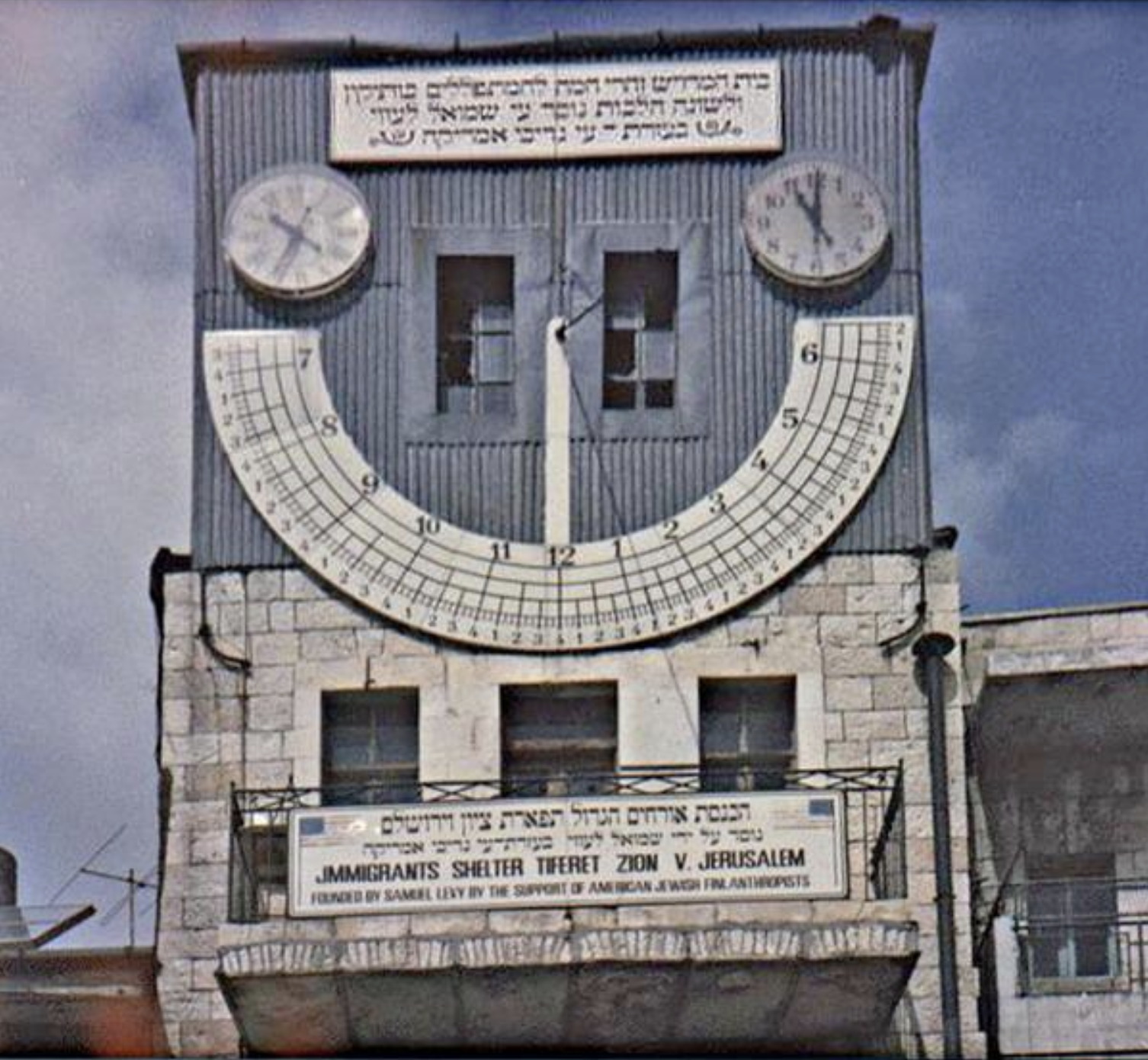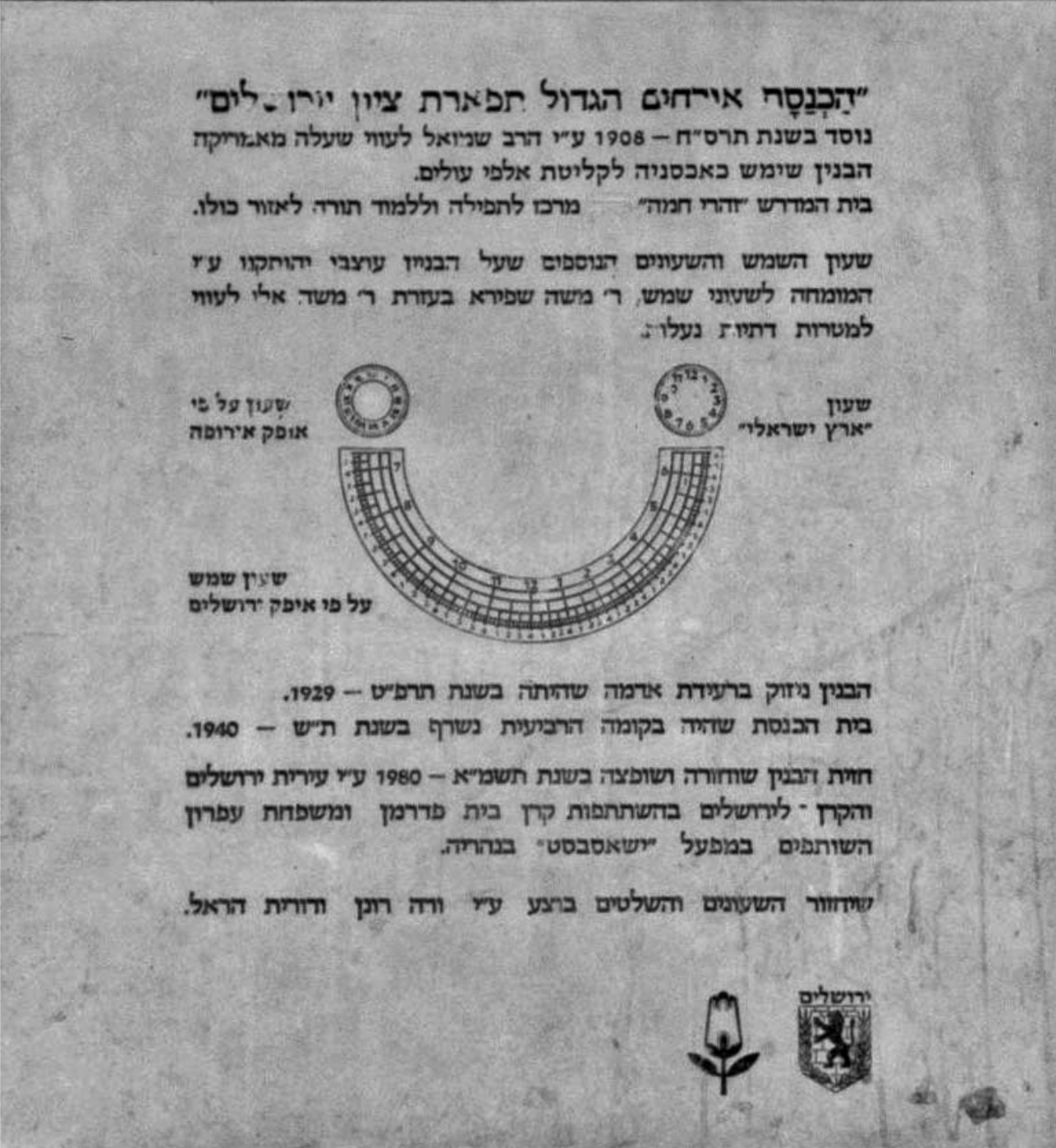Zoharei Chama
(The Sundial Building)
Click the button to open this page in a new tab that uses Google Translate.

“We walked by just before evening prayers one late afternoon, were invited inside and handed plates laden with homemade burekas! If you go all the way up Rehov Bibes, you come out on Rehov Agrippas. Cross through the open market at Rehov Mahaneh Yehuda or the enclosed market on Rehov Etz Hayim to reach Jaffa Road. Turn right and stop across from the historic structure at No. 92: Jerusalem’s first skyscraper.
The force behind this lofty building was American immigrant Rabbi Shmuel Levi, who constructed the three-story edifice at the beginning of the 20th century. Over the years it grew from three to five stories and was known for its hospitality to indigent pilgrims. On the fourth floor was the Zoharei Hama Synagogue, frequented by the venerated Arye Levin, the spiritual father to Hagana members imprisoned in Jerusalem’s British jail.
What makes this building so famous is its huge sundial. Moshe Shapiro, a rabbi from Mea She’arim who taught himself astronomy, put it up in 1908. Before its construction, haredim would climb the Mount of Olives and the slopes of the Bayit Vagan neighborhood to determine the exact hours of sunrise and sunset. The tower on the fourth floor tumbled down during an earthquake in 1927. Fourteen years later, a short circuit in the building caused a fire. The fifth story burnt down and the synagogue below was badly damaged. The facade was restored and the sundial reconstructed in 1980.
Two clocks on the front of the building were used in winter: One showed “European time” and the other showed halachic Jerusalem time.
Women aren’t allowed inside Zoharei Hama, an extremely modest synagogue where services take place throughout the day. Worshipers are a fascinating fusion of ages, backgrounds and ethnic groups, participating in afternoon prayers on the first floor (and rushing to get through them before sunset), then climbing to the second floor where evening services take place.
Prayers are not the only sounds that resonate from this historic synagogue. It is from Zoharei Hama that the sirens blast in Jerusalem, letting residents of the holy city know that it is time to light the Shabbat candles.”
“Of further historical interest is an edifice on Jaffa Road across the street from Machane Yehuda, still standing today. In 1906, the American immigrant Shmuel Levy bought a one-story house at the site. His intention was to add more stories and have the building serve as a hostel for new immigrants like himself. When the additions were completed, he consecrated the ground floor as a synagogue, called Zoharei Chamah (Sunrise) Synagogue, which still serves the area. The upper floors were guest rooms, which Levy provided as a public service. In addition, he commissioned Rav Moshe Shapiro, whose natural engineering talents were honed by his Talmudic studies, to construct a mammoth sundial outside the fourth floor. Levy also added two smaller conventional clocks on each side of the sundial (one on European time and one on Arabic time), so that people could know the hour even on cloudy days. The dial can still be seen, accurately tracking the sun’s progression as it has for decades.
Shmuel Levy’s four story building, which still stands today across the street from the Machane Yehudah shuk, included a synagogue on the ground floor and a hospice. The sundial was added later. in order to cover the costs of construction and upkeep, Levy sold lottery tickets like this one {see below}, each worth 20 francs. Two grand winners received 2,000 francs each.”
— Where Heaven Touches Earth: Jewish Life in Jerusalem from Medieval times to the Present by David Rossoff; Feldheim Pub: August 1, 1998
Sefer ha-Zikharon, R. Samuel Levi, Jerusalem 1921
“Rare bi-lingual Yiddish-English booklet describing the activities of the Tifferet Zion Jerusalem general immigrant Shelter and home. It has greetings and blessings for the year 5682 (1921/22) and gives an account of the work done by the institution. The Hebrew section has photos of the home’s building and of its founder, R. Samuel Levi. There is an accounting of its expenses, $4761.00 and income $2335.00, leaving a balance of $2429.00. During the year 5681-1921 6,950 immigrants lodged in Tifferet Zion. The institution has 15 rooms and 50 beds. The booklet describes the rooms and its occupants. For example, Room no. 12 belongs to Mrs. S. Verbovski, Brooklyn. It is furnished with 2 beds Nos. 41 and 42. No. 41 belongs to Mother , Mrs. R. R. Laski. Next some activities, such as synagogue services are described. This is followed by verification from F. Solverstone, Rabbi of Washington and H. Maslianski. The booklet is an insight into an aspect of life in Jerusalem of the period after World War I and the settlement of Eretz Israel, providing an aspect of institutional charitable work.
The Sundial Building or the Mahane Yehuda Clock Tower, is a four-story building on Jaffa Road which features a huge, 5 metres (16 ft) diameter sundial on its façade. The building, constructed in stages by R. Shmuel Levy from 1908–1917, was built to house a hostel for immigrants and a synagogue. It was damaged by fire in 1941 and partly restored by the Jerusalem municipality in 1980. Today it still houses the Zoharei Chama Orthodox synagogue, which has prayer services throughout the day for local businessmen, residents and tourists. The sundial is still accurate to within 15 minutes.
The aerial sundial on the fourth floor of the building was designed by Rabbi Moshe Shapiro, a watchmaker in Mea Shearim and a self-taught astronomer who had learned the science by studying the pertinent writings of Maimonides and the Vilna Gaon. Shapiro had built sundials for the outside walls of other synagogues, such as the Hurva Synagogue in Jerusalem’s Old City, and would go on to build sundials for at least 15 other synagogues in Israel, including Petah Tikva’s Great Synagogue.
Sundials were of crucial use for Haredi synagogue-goers who needed to know the exact time of sunrise to begin their morning prayers (vasikin), the exact time of sunset to complete their afternoon prayers, and the time for lighting Shabbat candles, since these times vary day by day and season by season. Before the Zoharei Chama sundial was erected, Haredi Jews would climb to the top of the Mount of Olives or the hills of the Bayit Vegan neighborhood each morning and evening to observe the times of sunrise and sunset. The third floor of Levy’s building originally included an eastern-facing wooden porch which allowed worshipers to easily see the sunrise.”
Sundial Building Poster
I know the print is tiny (and in Hebrew)…if you click on the image it will open it up in a lightbox and you can click on the magnifying glass with a plus sign to enlarge the image. I am working on translating the whole page.
The family tree shows the lineage of his wife Channa Ita.
Interesting Links

This is my oldest photo of the sundial tower, dating back to 1910. It was published on the cover of a book by Zadok Basan. Notice the structure on the 5th floor, which is now missing. It was an observation point for determining sunrise time over Mt. Olives.

Photo taken by Ephraim Friedman in 1950. Above the clock there are 3 separate signs, which are not present in any other photo. The lower sign is different from the one in 1910.

Another view from 1950, showing the ground floor. A concrete wall is shielding the entrance from bomb fragments, and part of the windows is blocked, typical of the 1948 war time. Additional floors were built on the adjoining buildings.

Artist drawing, probably from the 1960’s.

Unknown source and date. The façade of the top floor is new. The sign above the clock has been replaced (but is rusted). The sundial plate was repainted. The clock faces are new.

After restoration in 1980 by the city of Jerusalem. The sign below the clock is different than the 1950 sign.
Upper sign: Zaharei Chama seminary for “Mitpalelim Kevatikin and Shone Halachot” (I cannot translate this), established by Shmuel Levi with the aid of American philanthropists.
Lower sign: “Hachnasat Orchim Hagadol Tiferet Zion and Yerushalaim” (The rest is in English on the sign).

A sign attached at street level, as part of the 1980 restoration project.
“Hachnasat Orchim Hagadol, Tiferet Zion Jerusalem”
Established in 1908 by Rabbi Shmuel Levi, who immigrated from America.
The building was used as hostel for absorbing thousands of immigrants.
The “Zaharei Hama” seminary – a center for prayer and Torah studies for the entire region.
The sundial and additional clocks were designed and installed by the sundial expert R’ Moshe Shapira, with the aid of R’ Moshe-Elle Levi (Shmuel Levi’s son), for religious purposes (correct times for prayers and Shabbath).
The building was damaged in an 1929 earthquake. The 4th floor synagogue was burnt in 1940. (Another version says it was used for firewood by Turkish soldiers (before 1918).
The building front was restored in 1980 by the city of Jerusalem and the Jerusalem fund, with the Federman family fund and the Efron family, owners of Isasbest Naharia.
Restoration of the clocks and signs was done by Vera Ronen and Dorit Harel.






